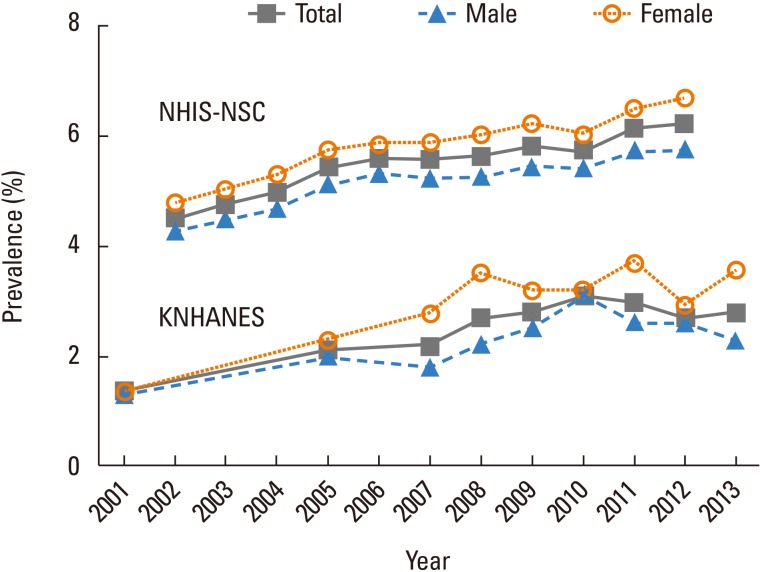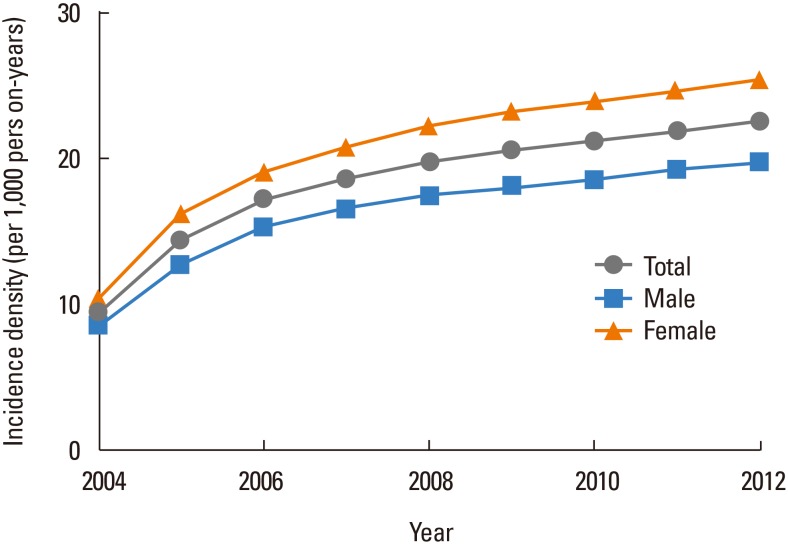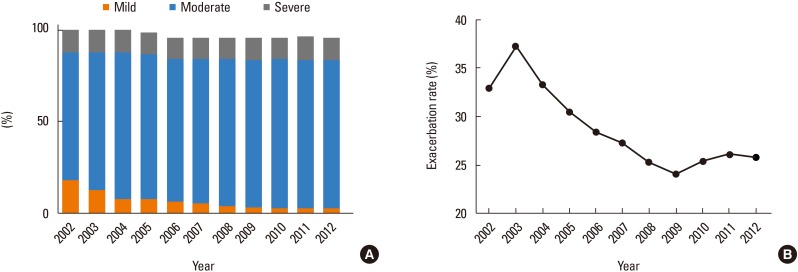High Prevalence of Asthma in Elderly Women: Findings From a Korean National Health Database and Adult Asthma Cohort
- Affiliations
-
- 1Department of Allergy and Respiratory Medicine, Konkuk University Hospital, Seoul, Korea.
- 2Department of Internal Medicine, Seoul National University Bundang Hospital, Seongnam, Korea.
- 3Department of Internal Medicine, Haeundae Paik Hospital, Inje University, Busan, Korea.
- 4Department of Allergy and Clinical Immunology, Asan Medical Center, University of Ulsan College of Medicine, Seoul, Korea. yscho@amc.seoul.kr
- 5Department of Medical Bioscience, Graduate School, Soonchunhyang University, Asan, Korea.
- 6Graduated School of Public Health, Seoul National University, Seoul, Korea.
- 7Division of Allergy and Respiratory Medicine, Soonchunhyang University Bucheon Hospital, Bucheon, Korea.
- KMID: 2421673
- DOI: http://doi.org/10.4168/aair.2018.10.4.387
Abstract
- PURPOSE
The prevalence and burden of asthma is increasing worldwide. In this study, we analyzed 3 different Korean national health survey datasets to determine the general features of adult asthma in Korea and to obtain basic information that would support future strategies for better management of adult asthma.
METHODS
The surveys used in this study included the Korea National Health and Nutrition Examination Survey (KNHANES), Korea Community Health Survey (KCHS) and National Health Insurance Service-National Sample Cohort (NHIS-NSC). We investigated annual asthma prevalence, evaluating the rate and risk factors of asthma exacerbation by age and sex, and clinical data of 1,832 patients with asthma who were registered in the Cohort for Reality and Evolution of Adult Asthma in Korea (COREA) were analyzed to elucidate risk factors for asthma exacerbation. We also analyzed another asthma cohort and added it as replication data.
RESULTS
In the KNHANES database, annual asthma prevalence rates varied from 1.2% to 3.1%. In the KCHS database, overall prevalence increased, with significant regional differences (1.6%-2.1%). The NHIS-NSC indicated a gradual increase in annual asthma prevalence from 4.5% to 6.2%. Interestingly, all 3 surveys indicated the highest prevalence of asthma among elderly women. In addition, elderly women with asthma had a significantly higher risk of asthma exacerbation (odds ratio [OR], 1.87; 95% confidence interval [CI], 1.19-2.93; P=0.006). Approximately 11% of patients were classified as having severe asthma. An asthma cohort analysis identified female sex, low baseline pulmonary function, longer treatment duration, high variability in pulmonary function and significant changes in Asthma Control Test scores as risk factors for asthma exacerbation.
CONCLUSIONS
The prevalence of asthma in Korea is consistently high among elderly and female populations. These results should lay the foundation for strategies for effective asthma prevention and management; elderly female patients with asthma should receive particular attention.
Keyword
MeSH Terms
Figure
Cited by 6 articles
-
Expression of Muscarinic Receptors and the Effect of Tiotropium Bromide in Aged Mouse Model of Chronic Asthma
Ji Young Kang, In Kyoung Kim, Jung Hur, Seok Chan Kim, Sook Young Lee, Soon Seog Kwon, Young Kyoon Kim
Tuberc Respir Dis. 2019;82(1):71-80. doi: 10.4046/trd.2018.0049.Prescription Patterns and Burden of Pediatric Asthma in Korea
In Suk Sol, Yoon Hee Kim, Soo Yeon Kim, Sun Ha Choi, Jong Deok Kim, Bo Ok Kim, Ji Eun Moon, Kyung Won Kim, Myung Hyun Sohn
Allergy Asthma Immunol Res. 2019;11(2):280-290. doi: 10.4168/aair.2019.11.2.280.Genes and Pathways Regulating Decline in Lung Function and Airway Remodeling in Asthma
Gyu Young Hur, David H. Broide
Allergy Asthma Immunol Res. 2019;11(5):604-621. doi: 10.4168/aair.2019.11.5.604.Association Between Epithelial Cytokines and Clinical Phenotypes of Elderly Asthma
Bastsetseg Ulambayar, So-Hee Lee, Eun-Mi Yang, Young-Min Ye, Hae-Sim Park
Allergy Asthma Immunol Res. 2019;11(1):79-89. doi: 10.4168/aair.2019.11.1.79.Is Trabecular Bone Score a More Sensitive Marker for Osteoporosis in Asthmatics?
Cheol-Woo Kim
Allergy Asthma Immunol Res. 2019;11(3):302-305. doi: 10.4168/aair.2019.11.3.302.Increasing Prevalence and Mortality of Asthma With Age in Korea, 2002–2015: A Nationwide, Population-Based Study
Eunyoung Lee, Anhye Kim, Young-Min Ye, Sang-Eun Choi, Hae-Sim Park
Allergy Asthma Immunol Res. 2020;12(3):467-484. doi: 10.4168/aair.2020.12.3.467.
Reference
-
2. Uphoff EP, Cabieses B, Wright J, Pickett KE. International prevalence rates of asthma and allergy are associated with income inequality. J Allergy Clin Immunol. 2015; 136:189–190.e2. PMID: 25794657.
Article3. GBD 2015 Chronic Respiratory Disease Collaborators. Global, regional, and national deaths, prevalence, disability-adjusted life years, and years lived with disability for chronic obstructive pulmonary disease and asthma, 1990–2015: a systematic analysis for the Global Burden of Disease Study 2015. Lancet Respir Med. 2017; 5:691–706. PMID: 28822787.4. Song WJ, Kang MG, Chang YS, Cho SH. Epidemiology of adult asthma in Asia: toward a better understanding. Asia Pac Allergy. 2014; 4:75–85. PMID: 24809012.
Article5. Dunn RM, Lehman E, Chinchilli VM, Martin RJ, Boushey HA, Israel E, et al. Impact of age and sex on response to asthma therapy. Am J Respir Crit Care Med. 2015; 192:551–558. PMID: 26068329.
Article6. Haldar P, Pavord ID, Shaw DE, Berry MA, Thomas M, Brightling CE, et al. Cluster analysis and clinical asthma phenotypes. Am J Respir Crit Care Med. 2008; 178:218–224. PMID: 18480428.
Article7. Moore WC, Meyers DA, Wenzel SE, Teague WG, Li H, Li X, et al. Identification of asthma phenotypes using cluster analysis in the Severe Asthma Research Program. Am J Respir Crit Care Med. 2010; 181:315–323. PMID: 19892860.
Article8. Kim TB, Jang AS, Kwon HS, Park JS, Chang YS, Cho SH, et al. Identification of asthma clusters in two independent Korean adult asthma cohorts. Eur Respir J. 2013; 41:1308–1314. PMID: 23060627.
Article9. Kim Y. The Korea National Health and Nutrition Examination Survey (KNHANES): current status and challenges. Epidemiol Health. 2014; 36:e2014002. PMID: 24839580.
Article10. Lee J, Lee JS, Park SH, Shin SA, Kim K. Cohort profile: the National Health Insurance Service-National Sample Cohort (NHIS-NSC), South Korea. Int J Epidemiol. 2017; 46:e15. PMID: 26822938.
Article11. Global Initiative for Asthma. Global strategy for asthma management and prevention [Internet]. [place unknown]: Global Initiative for Asthma;2014. updated 2015 Aug 12. cited 2017 Nov 12. Available from: http://www.ginasthma.org/.12. Kim TB, Park CS, Bae YJ, Cho YS, Moon HB. COREA Study Group. Factors associated with severity and exacerbation of asthma: a baseline analysis of the cohort for reality and evolution of adult asthma in Korea (COREA). Ann Allergy Asthma Immunol. 2009; 103:311–317. PMID: 19852195.
Article13. Park HJ, Kim EJ, Yoon D, Lee JK, Chang WS, Lim YM, et al. Prevalence of self-reported allergic diseases and IgE levels: a 2010 KNHANES analysis. Allergy Asthma Immunol Res. 2017; 9:329–339. PMID: 28497920.
Article14. Centers for Disease Control and Prevention. Current asthma prevalence percents by age, sex, and race/ethnicity, United States. Atlanta (GA): Centers for Disease Control and Prevention;2015. updated 2016 Sep 8. cited 2017 Nov 12. Available from: https://www.cdc.gov/asthma/asthmadata.htm.15. Asthma Facts. CDC's National Asthma Control Program Grantees [Internet]. Atlanta (GA): Centers for Disease Control and Prevention;2013. updated 2013 Jul. cited 2017 Nov 12. Available from: https://www.cdc.gov/asthma/.16. Bishwajit G, Tang S, Yaya S, Feng Z. Burden of asthma, dyspnea, and chronic cough in South Asia. Int J Chron Obstruct Pulmon Dis. 2017; 12:1093–1099. PMID: 28435242.17. Ma Q, Yang T. Prevalence and influential factors for asthma among adults in Chinese. Zhong Nan Da Xue Xue Bao Yi Xue Ban. 2017; 42:1086–1093. PMID: 28989156.18. de Nijs SB, Venekamp LN, Bel EH. Adult-onset asthma: is it really different. Eur Respir Rev. 2013; 22:44–52. PMID: 23457164.
Article19. Westerhof GA, Coumou H, de Nijs SB, Weersink EJ, Bel EH. Clinical predictors of remission and persistence of adult-onset asthma. J Allergy Clin Immunol. 2018; 141:104–109.e3. PMID: 28438546.
Article20. Kim BK, Kim JY, Kang MK, Yang MS, Park HW, Min KU, et al. Allergies are still on the rise? A 6-year nationwide population-based study in Korea. Allergol Int. 2016; 65:186–191. PMID: 26666496.
Article21. Asher MI, Montefort S, Björkstén B, Lai CK, Strachan DP, Weiland SK, et al. Worldwide time trends in the prevalence of symptoms of asthma, allergic rhinoconjunctivitis, and eczema in childhood: ISAAC Phases One and Three repeat multicountry cross-sectional surveys. Lancet. 2006; 368:733–743. PMID: 16935684.
Article22. Triebner K, Johannessen A, Puggini L, Benediktsdóttir B, Bertelsen RJ, Bifulco E, et al. Menopause as a predictor of new-onset asthma: a longitudinal Northern European population study. J Allergy Clin Immunol. 2016; 137:50–57.e6. PMID: 26435006.23. Beuther DA, Sutherland ER. Overweight, obesity, and incident asthma: a meta-analysis of prospective epidemiologic studies. Am J Respir Crit Care Med. 2007; 175:661–666. PMID: 17234901.24. Newcomb DC, Cephus JY, Boswell MG, Fahrenholz JM, Langley EW, Feldman AS, et al. Estrogen and progesterone decrease let-7f microRNA expression and increase IL-23/IL-23 receptor signaling and IL-17A production in patients with severe asthma. J Allergy Clin Immunol. 2015; 136:1025–1034.e11. PMID: 26242299.
Article25. Kynyk JA, Mastronarde JG, McCallister JW. Asthma, the sex difference. Curr Opin Pulm Med. 2011; 17:6–11. PMID: 21045697.
Article26. Almqvist C, Worm M, Leynaert B. Working Group of GA2LEN WP 2.5 Gender. Impact of gender on asthma in childhood and adolescence: a GA2LEN review. Allergy. 2008; 63:47–57. PMID: 17822448.
Article27. Zierau O, Zenclussen AC, Jensen F. Role of female sex hormones, estradiol and progesterone, in mast cell behavior. Front Immunol. 2012; 3:169. PMID: 22723800.
Article28. Subbarao P, Mandhane PJ, Sears MR. Asthma: epidemiology, etiology and risk factors. CMAJ. 2009; 181:E181–E190. PMID: 19752106.
Article29. Mincheva R, Ekerljung L, Bossios A, Lundbäck B, Lötvall J. High prevalence of severe asthma in a large random population study. J Allergy Clin Immunol. Forthcoming 2017.
Article30. Chung KF, Wenzel SE, Brozek JL, Bush A, Castro M, Sterk PJ, et al. International ERS/ATS guidelines on definition, evaluation and treatment of severe asthma. Eur Respir J. 2014; 43:343–373. PMID: 24337046.31. Lefaudeux D, De Meulder B, Loza MJ, Peffer N, Rowe A, Baribaud F, et al. U-BIOPRED clinical adult asthma clusters linked to a subset of sputum omics. J Allergy Clin Immunol. 2017; 139:1797–1807. PMID: 27773852.32. Hancox RJ, Milne BJ, Poulton R, Taylor DR, Greene JM, McLachlan CR, et al. Sex differences in the relation between body mass index and asthma and atopy in a birth cohort. Am J Respir Crit Care Med. 2005; 171:440–445. PMID: 15557135.
Article33. Hanania NA, King MJ, Braman SS, Saltoun C, Wise RA, Enright P, et al. Asthma in the elderly: current understanding and future research needs--a report of a National Institute on Aging (NIA) workshop. J Allergy Clin Immunol. 2011; 128:S4–S24. PMID: 21872730.
Article34. James AL, Palmer LJ, Kicic E, Maxwell PS, Lagan SE, Ryan GF, et al. Decline in lung function in the Busselton Health Study: the effects of asthma and cigarette smoking. Am J Respir Crit Care Med. 2005; 171:109–114. PMID: 15486340.35. Hekking PP, Wener RR, Amelink M, Zwinderman AH, Bouvy ML, Bel EH. The prevalence of severe refractory asthma. J Allergy Clin Immunol. 2015; 135:896–902. PMID: 25441637.
Article36. Baptist AP, Hamad A, Patel MR. Special challenges in treatment and self-management of older women with asthma. Ann Allergy Asthma Immunol. 2014; 113:125–130. PMID: 25065349.
Article





